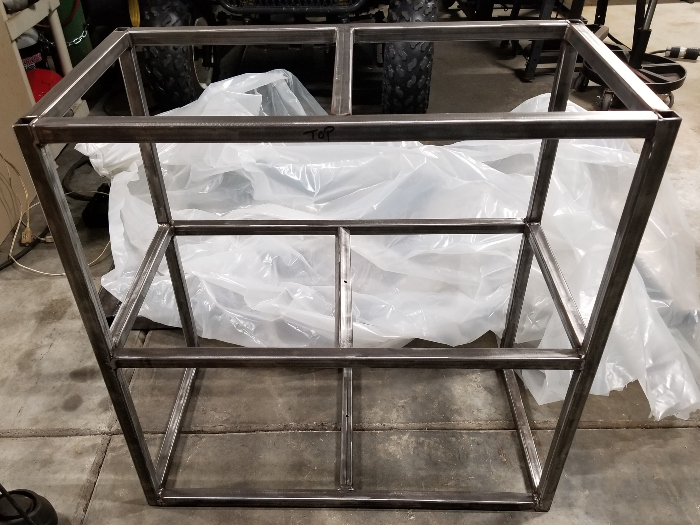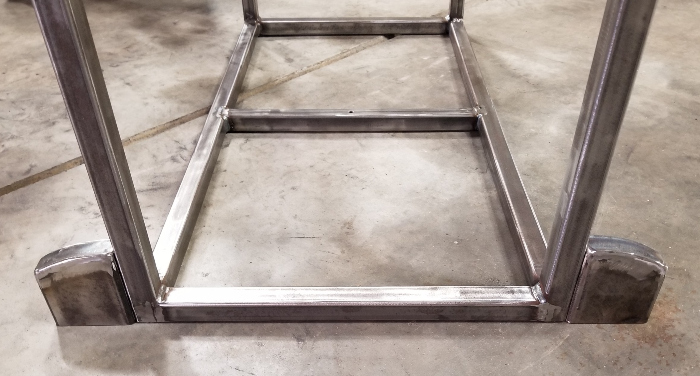Lofty Aspirations
October 26th, 2022Rising to the Occasion
The workshop is becoming more and more orderly and less dysfunctional every week. Can the rest of my life be far behind? The other day, I was praying, and I heard myself saying, “Order my life,” over and over. Yesterday or the day before, I heard, “Your habits are important.” Little words and phrases that come from God can make big changes in your life.
I bought myself a big ice cream maker with built-in refrigeration, and I also got a deep fryer and a Ronco rotisserie. As a result, my counters look like Fred Sanford’s yard. I started building a kitchen cart to hold these things, but I got distracted, possibly by the unexpected courtship that led to me marrying my wonderful wife. I had built most of the frame of the cart, but it sat and rusted after that.
Rust was never a problem in Miami. I was led to believe that things rusted quickly in warm, humid places, but the opposite is true.
Rust is caused by condensation more than above-average humidity. When you have sudden temperature swings, things that are cold collect water until they warm up. Then they rust. Sudden swings happen all the time in most of America, but the closer you get to the tropics, the rarer they are.
Where I live now, I have to cover bare iron up or spray it with greasy concoctions unless I want rust.
This week, I started working on the cart again, and I had to begin with about an hour of knocking rust off with an angle grinder and a paint-stripping wheel.
As of last night, I had the frame nearly done. I have to weld one more piece of tubing into it, and I also have to add two attachments to set one pair of wheels farther apart than the other two.
When I started working on this thing, I was under the impression it had to be very square. I was planning on welding 4 plate casters on the bottom, and if you have 4 wheels on a rigid object, and they’re not in exactly the same plane, the object will rock or one caster won’t touch the floor. I welded it up carefully, but it’s still off by almost 1/8″. Since starting the project, I have realized the answer isn’t perfect fabrication; it’s casters with stems.
A lot of products have casters or feet on threaded stems. The reason is that you can adjust their height to make up for small errors in the construction of the products.
Yesterday, I made three little pucks of steel, and I drilled and tapped them. I’m going to weld them into the bottom of the cart and use stem casters.
I have also learned that every 4-wheeled object should have one set of wheels that are farther apart than the others. Or closer together, if you look at it that way. A trapezoidal footprint makes it impossible for an object to rock. It can fall over, but it can’t rock back and forth, and rocking can lead to tipping. Also, increasing the length of one axle will make tipping harder even without considering rocking. It puts the center of gravity farther inboard from the wheels.
To increase the width of one set of wheels, I made these things out of 1″ by 3″ tubing:
I will weld them onto one pair of vertical tubes on the cart, and I’ll put the caster nuts I made in them, as far out as possible.
I have also replaced all the lights in my shop. LED’s are improving at a furious pace.
Where I used to have two relatively expensive 4000-lumen fixtures that were built in, I now have 4 3000-lumen jobs from Home Depot, wired to trusses. They cost me $17 each. They don’t have tubes, so they cost less. I can’t replace dead tubes when they go out, but the fixtures cost about the same amount of money as two tubes, so it doesn’t matter. I hardwired them pretty easily.
I had two somewhat dim 4-foot LED lights over three areas in the shop. I went to Harbor Freight and got three 5000-lumen replacements for $17 each. The quality appears to be about the same. China is China.
I bought my self 16 feet of white LED strip lighting, and I put it in my shelf complex.
These things come with an adaptor that plugs into one end. This is a problem if you want to have the adaptor and switch in the middle, along with a stretch that doesn’t give off light. If you run a strip through two cabinets, you don’t want light between the cabinets. I figured there had to be a way to splice them.
Turned out I was right. I put 42″ of wire between two 8-foot sections. Now the switch is where I want it to be, and I don’t have a useless strip of light running across the wall.
You can splice them with a soldering iron and shrink tubing. Look it up if you’re interested. It’s simple. They also make clips to splice LED strips, but people say they are unreliable.
I got the strip lights as a lark. They’re not a permanent solution. LED strips are pretty tacky if you can see them, and I can see mine. They’re best for indirect light, so the strips are concealed. They’ll do for now, though.
I got my smallest leaf blower running. It’s a tiny Husqvarna I’ve had since Miami. It would be worthless for cleaning up a yard, but it’s perfect for a workshop with big doors. At the end of a session, you vacuum up anything that can damage concrete (steel filings=rust stains), you fire the blower up, and you blow everything else out into the yard. My big electric blower would actually be better, but the Husqvarna is light and convenient, and it’s important to run small engines frequently because leftists have ruined the world with ethanol gas that kills carburetors and other parts.
I was thinking of putting up a second building, and I got an estimate. Now I want to make the most of my existing building first. To that end, I am considering building a loft and an elevator.
You would think putting an elevator in a workshop would cost thousands of dollars, but it doesn’t. An OSHA-approved elevator with all the bells and whistles would probably cost as much as a Cadillac, but you don’t need that kind of equipment in a home shop. You just need a platform that goes up and down without killing anyone.
Somebody came up with a way to combine a cheap winch, steel struts from Home Depot, rollers, and plywood to make an elevator that will move a person and maybe 350 pounds of stuff, depending on how fat the person is. I’ll embed a video chosen at random.
I had thought about building a loft, but a loft usually means stairs or a ladder. I am not going to carry things up a ladder, and stairs would take up maybe 30 square feet and make it hard to get around the shop. With an elevator, I can put things like a pressure washer or generator on the platform, get on with them, and ride up in comfort. An elevator would only take up maybe 12 square feet, and it would be against a wall, out of the way.
The added bonus of an elevator is that you can leave it about three feet from the floor and use it as a workbench.
If I had a loft, I could get some big things off the floor. I have a portable table saw, a pressure washer, and a sliding miter saw. I could also put shelves in the loft and use them for things that are rarely used but too good to throw out. Big jugs of machinery oil, for example.
My walls are only 12 feet high, so in order to get a reasonable height under the loft, I would have to make do with around 5 feet between the loft and the ceiling, but that’s a whole lot better than nothing, and I wouldn’t be playing basketball up there.
I would have to add a built-in ladder in case the power went out while I was up there, but that would take up almost no room.
It can be done. It has been done.
The only question is how big to make it. I’m thinking maybe 6 feet by 16. I don’t want to put a whole wall in the shade. If I change my mind, adding more loft space would be simple.
There are a lot of Youtube videos featuring shopmade elevators, and there is a lot of negativity in the comments. “Kids will hurt themselves.” “You’ll get your foot caught between the elevator and the stuff beside it.” “The cable will break, and you’ll fall.” A smart person put up the obvious response, saying shops are already full of dangerous things. A band saw can take a finger off in a hurry. Grinders can kill in an instant. A lathe can roll an arm up like a sock. Somehow these things are okay, but an elevator is too perilous? Not listening.
The fall hazard can be negated pretty easily. They make contraptions that catch things when they start to fall.
It looks like an elevator can be installed for well under a grand, and it’s not a really big job.
I may also build a shed. I can buy a little one for $600, but I would like to have one big enough to put the utility cart and garden tractor in when I’m using the shop. Just to keep the rain off. I think it would be a simple matter of installing 6 four-by-four poles with concrete slugs and running boards between them, with steel roof panels above.
When the loft and elevator are done, I can put in a split AC unit. I have until about mid-April to get that done. The weather should be acceptable until then. I’ll want a drywall ceiling with insulation, as well as an new insulated roll-up door and insulation for the conventional garage door.
That’s about all the shop news. If I go through with the loft plan, of course I’ll post photos.


October 27th, 2022 at 12:56 PM
Now you’ve got me thinking.
I’ve got an attic access that doesn’t warrant a drop down extending staircase. But a winch up there with a trapeze rung would get me up and down easily.
October 27th, 2022 at 1:18 PM
A rung? Are you Ed Wallenda now? I kind of like the platform.
Almost forgot my disclaimer.
It’s a bad idea! It’s incredibly dangerous! Don’t sue me!
I plan to say these things every time I mention any project from now on.